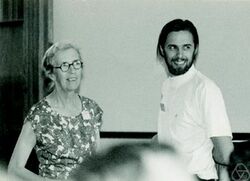Biography:Charles C. Pugh
Charles C. Pugh | |
|---|---|
 Charles Pugh, Berkeley, 1993 | |
| Born | United States |
| Nationality | United States |
| Citizenship | United States |
| Alma mater | Johns Hopkins University (PhD) |
| Known for | Work in dynamical systems |
| Scientific career | |
| Fields | Mathematics |
| Institutions | University of California, Berkeley |
| Thesis | The Closing Lemma for Dimensions Two and Three (1965) |
| Doctoral advisor | Philip Hartman |
| Website | https://math.berkeley.edu/people/faculty/charles-c-pugh |
Charles Chapman Pugh (born 1940) is an American mathematician who researches dynamical systems. Pugh received his PhD under Philip Hartman of Johns Hopkins University in 1965, with the dissertation The Closing Lemma for Dimensions Two and Three.[1] He has since been a professor, now emeritus, at the University of California, Berkeley.
In 1967 he published a closing lemma named after him in the theory of dynamical systems.[2] The lemma states: Let f be a diffeomorphism of a compact manifold with a nonwandering point x.[3] Then there is (in the space of diffeomorphisms, equipped with the [math]\displaystyle{ C^1 }[/math] topology) in a neighborhood of f a diffeomorphism g for which x is a periodic point. That is, by a small perturbation of the original dynamical system, a system with periodic trajectory can be generated.
In 1970 he was an invited speaker at the International Congress of Mathematicians in Nice, delivering a talk on Invariant Manifolds.
Books
- Real Mathematical Analysis, Springer-Verlag, 2002
Notes
- ↑ Charles C. Pugh at the Mathematics Genealogy Project
- ↑ Pugh An Improved Closing Lemma and a General Density Theorem, American Journal of Mathematics, Band 89, 1967, S.1010–1021, "Closing Lemma" by Christian Bonatti in Scholarpedia
- ↑ Wandering points were introduced by George Birkhoff to describe dissipative systems (with chaotic behavior). In the case of a dynamical system given by a map f, a point wanders if it has a neighborhood U which is disjoint to all of the iterations of the map on it: [math]\displaystyle{ f^n(U) \cap U = \varnothing.\, }[/math]


